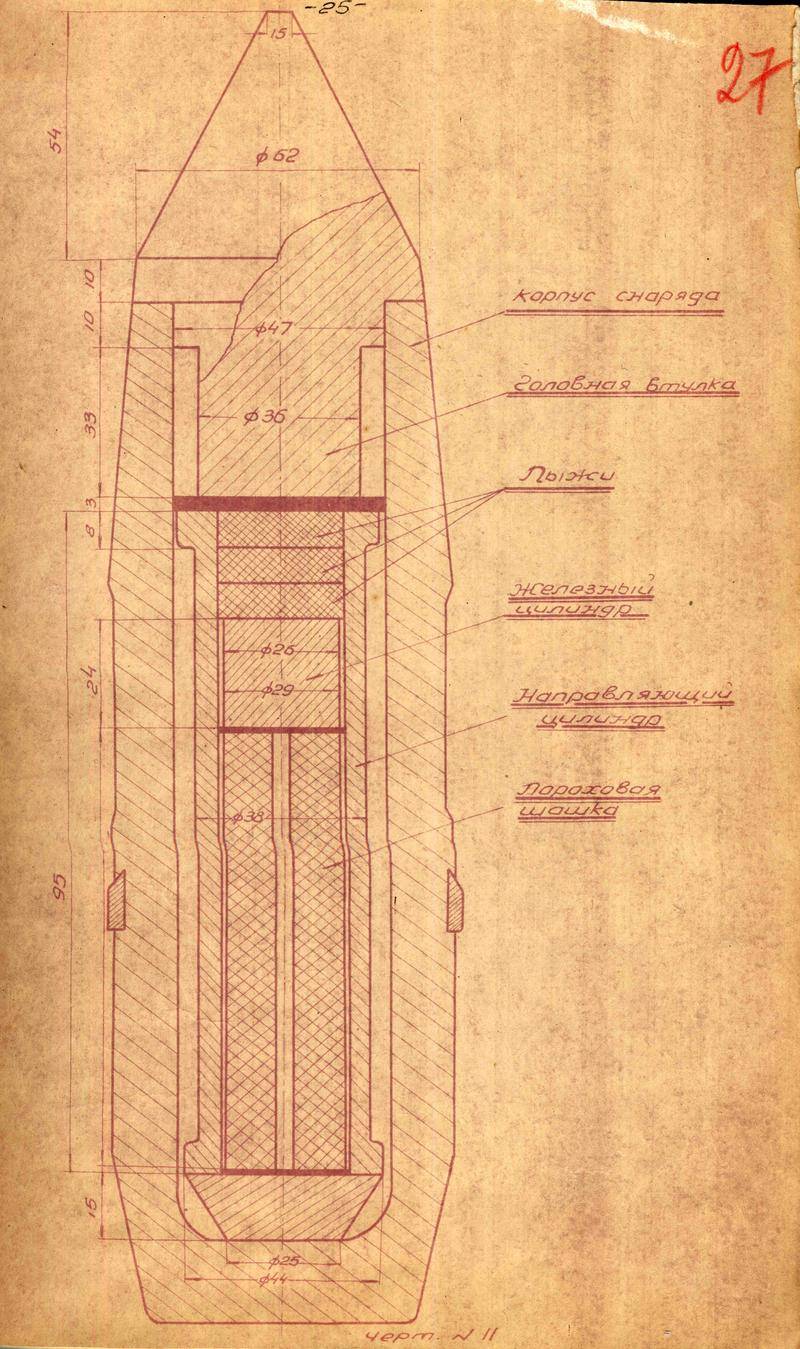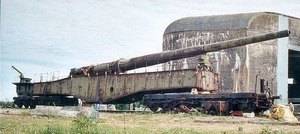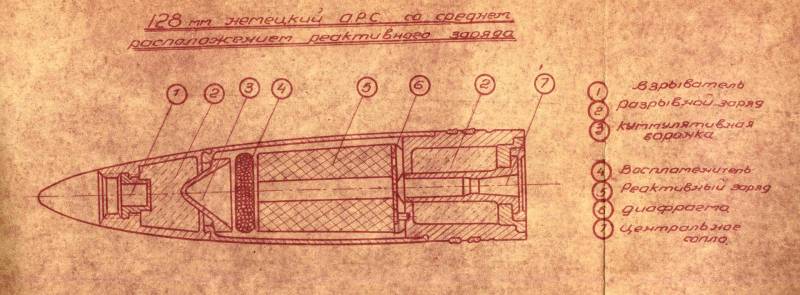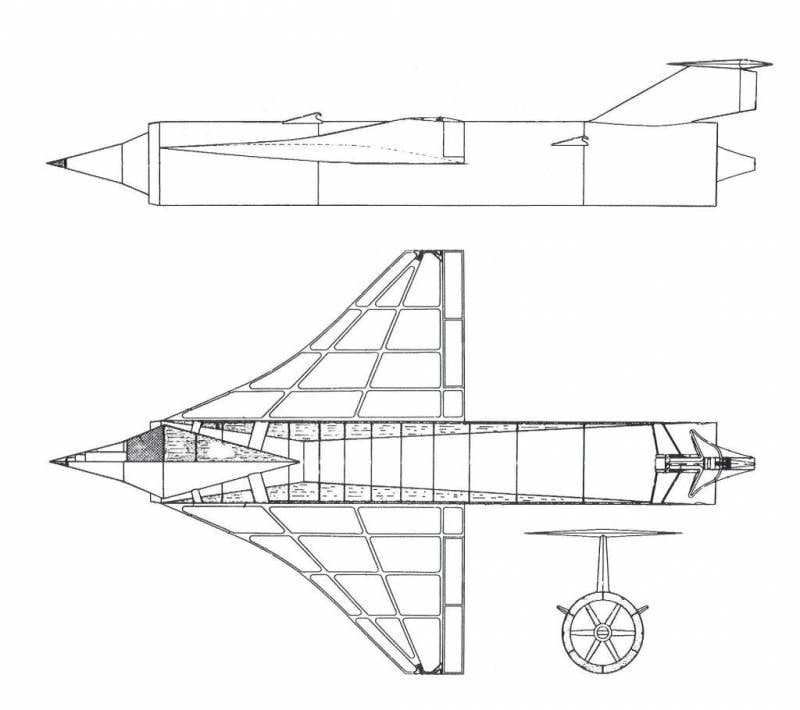Active-missiles: how it works
The development of active rockets under the code name "special ammunition" in early 1943, we led the People's Commissariat aviation industry, and specifically - NII-1. The goal is to increase the firing range when using standard guns. On the instructions of the Main Artillery Administration, shells were developed for the ZIS-3 divisional cannon (76 mm), the hull gun arr. 1910/34 g. (152 mm) and regimental mortar (120 cm). The rather old 152-mm cannon was chosen, perhaps because its shells and charges were unified with a new hull gun - the ML-20 howitzer gun.
Naughty checkers
76-mm APC was obtained as a result of alteration of the standard high-explosive fragmentation grenade mass 6,28 kg. Since it was necessary to build the engine into the projectile, it was necessary to divide it into a warhead with a explosive charge and a jet chamber, into which the single-channel H-40 / 8-150 gunplate weighing 0,285 kg was placed. Gases from the combustion of gunpowder expired through six nozzles in the bottom of the projectile, it also provided a hole for the igniter. What is characteristic of ARS, due to the introduction of a reactive charge, the weight of the explosive in the projectile decreased from 760 g to 200 g. At the same time, the range increased by only one and a half kilometer - from 13,3 to 14,8 km.
128-mm German ARS with an average arrangement of a jet charge
152-mm APC with a mass of 43,6 kg was also created on the basis of a standard high-explosive fragmentation projectile. But 120-mm APC was a new design with 31,5 kg mass versus regular 120-mm mines with 16 kg mass.
During the ground tests of 1944 − 1945, it turned out that in 76-mm and 152-mm APC, the powder checkers were cracked when fired. This led to uneven combustion of the fuel, pressure surges and, as a result, an explosion. The exception was the 120-mm mortar shells - apparently, it was the fact that they were re-designed. However, they failed to test them: the war came to an end.
Same way
The famous rocket designer Boris Chertok, in his memoirs about traveling to post-war Germany to study the engineering heritage of the Third Reich, once noted that, despite the distances, borders, and military-political obstacles, science developed in the USSR, in Germany, and in the USA parallel paths, as if scientists were connected by some kind of telepathic connection. Studying the German trophies, representatives of the Soviet defense industry could see that the topic of the ARS was quite close to our just defeated opponents.

76-mm Soviet ARS
Work on active-projectiles was launched in Germany in 1934, and immediately before the designers were identified the main problems. Not only did the need for placing a jet chamber reduce the weight of the explosive charge, but the accuracy of fire also worsened: stabilizing the missile in flight is a task far more complicated than stabilizing a cannon shell. Initially, experiments were carried out with calibers 75 and 100 mm, and black powder was used as rocket fuel. However, here the Germans had the same difficulties as later with domestic designers: the powder checkers cracked, the shells exploded prematurely.
Only in 1938, the DAG company in the city of Düneberg was able to create a technology for pressing durable checkers of smokeless powder and a reliable ignition scheme. Only then was it possible to achieve reliability from projectiles and to increase their range by 30%.
Did the powder accelerator significantly increase the range of a gun shot?
Soviet designers managed to get the greatest "gain" in the creation of an ARS based on the 152-mm standard high-explosive fragmentation projectile. The new projectile had a weight of 43,6 kg, and its powder charge consisted of 110 / 10 − 300 brand NGV checkers of weight 4,35 kg. The weight of the explosive had to be reduced from 6,25 kg to 4,55 kg. But the jet engine reported an additional speed of 200 m / s to the projectile, which resulted in an increase in the range from 16,2 km to 22,45 km. Thus, from the entire Soviet artillery further (up to 25 km) only 152-mm high-power cannon of the BR-2 could fire, and there were only 30 units in the ARGK.
In 1939, 150-mm R.Gr.19 active-projectile was developed for heavy field howitzers arr. 18 and 18 / 40. After the test, the projectile was put into service.
Reach out to britain
Despite a number of successful designs, the Germans quickly realized that the advantages of an active-reactive scheme can be most pronounced when applied not to field artillery, but to ultra-long range shooting. In an era when rocket weapons had not yet demonstrated their effectiveness, Germany relied on giant cannons and gigantic shells. One of such super-guns was the K5 (E) railway gun with 280 caliber mm. The 32 long cannon was m 218 tons of weight and was based on two six-axle railway platforms.
In order to increase the firing range, during the war, Raketen-Granate 4341 active-missiles 245 kg were built for this gun, called “Slender Bertoy”. The engine fuel was 19,5 kg of diglycolic powder. The firing range of the Raketen-Granate 4341 was 87 km, that is, the gun could shoot from a number of southern British cities from Calais or Boulogne.
For the first time in supersonic
However, the most interesting development of the topic of an artillery projectile with jet acceleration was in the works of the German designer Wolf Trommsdorff. Instead of a powder accelerator, he conceived to equip the projectile ... with a ramjet engine. Trommsdorff proposed his idea to the Armaments Directorate of the Third Reich back in October 1936, and German military officials took the idea unexpectedly favorably. The scientist was allocated a laboratory for experiments with the famous "akht-komma-aht" - an anti-aircraft gun of 88 mm caliber, which later formed the basis of a whole line of field and tank guns. The E1 projectile (according to some sources, sub-caliber, with a pallet) was first tested in 1939, although at first not with a ramjet engine, but with an accelerator in the form of a powder checker. In 1942, finally, a liquid fuel projectile was tested, which was a mixture of carbon disulfide and diesel fuel. The oxidizing agent was, naturally, atmospheric oxygen. The projectile flew at a speed of 920 m / s, which is about 3 M. So for the first time in history, supersonic flight using an air-jet engine was demonstrated. Trommsdorff did not stop there, and during the Second World War he developed shells for calibers 105 mm (E2), 122 (E3) and 150 (E4). The latter developed a speed of up to 4,5 M, using the same carbon disulfide as fuel.
In 1943, the C1 projectile was created for the 210-mm gun. From 90 kg, the mass of this 6 kg was accounted for rocket fuel. Thanks to the work of the ramjet engine, the speed of the C1 projectile reached 1475 m / s, and the range - 200 km.
D-6000: intercontinental cruise missile project. The sketch clearly shows the spindle-shaped central body of the diffuser - one of the main elements of a ramjet engine.
Next, Trommsdorff was to perform in a heavy weight. Inspired by the experiments with the APC, which were intended for the super-gun K5 (E), the designer takes up the creation of the C3 long-range mega-charge, in which the air-jet ramjet engine will act as an accelerator instead of a rocket engine. With the declared length of 1,35 m, weight 170 kg and caliber 280 mm С3 had to reach speeds up to 5,5 M and fly to a distance of 350 km, which would completely allow the French coast to keep a good half of England under fire. The muzzle velocity of the projectile would be 4400 km / h. It was supposed to use diesel fuel as fuel in the engine, which was ignited by hot air from compression (as happens in a diesel engine). By the way, it is precisely the achievement of the required air density that constitutes one of the main problems in the design of direct-flow engines. In engines of this type, in contrast to turbo-jets, there is no turbine-compressor, and air is compressed during deceleration of the incoming flow in a special inlet device - a diffuser. Air flows around the needle (conical protrusion) of the central body of the diffuser, and then rushes into the annular channel. The configuration of the central body is such that in the process of flow around it there are shocks of compaction - several oblique shocks and one closing straight line. Such a multi-jump scheme, which allows to avoid losses during air deceleration, was developed by a Slovenian-Austrian researcher in the field of gas dynamics Klaus Osvatich (1910 - 1993). Wolf Trommsdorff had the opportunity to talk personally with Osvatich and other luminaries of gas dynamics like Ludwig Prandtl, when he was invited to work at the famous Kaiser Wilhelm Institute (now Max Planck) before Gottingen before the war. Later, the designer managed to test and apply the ideas of his consultants in practice. However, apparently, not a single shot of a C3 projectile from a K5 cannon (E) was made before the end of the war.
 Cannon K.5 Schlanke Berta
Cannon K.5 Schlanke BertaThe design of the 280-mm ultra-long-range rail gun K5 (E) was launched by Krupp in the 1934 year. The first barrel was shot in 1936 year. The K5 (E) gun had a very long barrel, 1,5 — 2 times longer than other railway or sea 280-mm guns. For this, the German soldiers called K5 (E) "Slender Berta" ("Schlanke Berta"). By 1 September 1939 had three K5 (E) and 360 cannons with Gr.35 shells in service. The cost of one installation was 1,25 million Reichsmarks. In 1939, two K5 (E) installations were made, in 1940, in 3, in 1941, in 2, in 1942, in 8, in 1943, in 2. The first samples of the trunks were designed for firing projectiles with protrusions and had 12 deep rifling (depth 6,75 mm). The width of the rifling 15,88 mm, the steepness of the constant 5,5 °.
The Harbinger
A logical continuation of Trommsdorff's work on the ARS with a ramjet engine was the D-6000 project - one of the attempts of Nazi engineers to give Reich "long hands" and offer an asymmetric response to the total domination of the Anglo-American bomber aircraft. We are talking about an intercontinental cruise missile, which could theoretically reach a punishing sword from the European coast to the New World. At first, the D-6000 was seen as a two-stage system. According to Trommsdorff, a rocket of length 10,2 m, diameter 1,12 m and mass 9 t was to be raised with the help of a bomber to the height 8 000 m, from where it was supposed to launch. At a later stage of development of the theme, it was decided to launch the catapult installed on the ground. After the start, solid-fuel boosters fixed at the ends of the wings would accelerate the D-6000 to 850 m / s, after which the direct-flow engine was switched on. He had to bring the velocity of the projectile to 3,55 M and send it on a cruising flight at 24 000 m. Having spent 5 tons of fuel, a rocket, if it had ever been embodied in metal, could have thrown 1 tons of warheads 5300 km. There are also unconfirmed reports that a ballistic missile of the type V-2 was considered as the first stage for launching this projectile, but the V-2 itself, in the form in which we know it, could not cope with this task due to insufficient power. D-6000 has remained a project, but it seems to have unofficial descendants. In the 1940 - 1950-ies in the USSR and the United States were developing intercontinental supersonic cruise missiles with a ramjet engine to deliver a nuclear warhead to the territory of a potential enemy. In America, this is the North American Navaho project, and in our country, La-350 “Storm”, which was built in the Lavochkin Design Bureau. Both projects led to the creation of flying samples, and both were discontinued for the same reason — ballistic missiles proved to be more promising for the task.
Mysterious decade
It is important to note that the Soviet designers managed to get acquainted with the ideas of Trommsdorff directly. After the end of the war on the territory of defeated Germany, the Soviet authorities in the deepest secret created two rocket scientific research institutes whose task was to actively learn from the experience of German designers, including with their direct participation. One of these research institutes was organized on the basis of the Berlin plant "Gema" and was named "Berlin". The institute was tasked with collecting material on anti-aircraft guided missiles and ground-based rockets created in Germany and repeating these structures in metal. "Berlin" was divided into several KB. For example, KB-2 studied the Wasserfal missiles, KB-3 - Schmetterling and Reintochter missiles. But the share of KB-4 under the leadership of N.A. Sudakov had a job with Trommsdorff's legacy, and the scientist himself took the lead designer position in this design bureau. At that time, the focus of interest of the Soviet defense industry was on the ARS С3 - the very 280-mm projectiles that were fired from the K5. Trommsdorff was asked to make a modified version of the ARS, which was supposed to be tested on repaired trophy implements. However, for a not very understandable reason, the work on ARS was curtailed some time later. Perhaps, the role played by the war of ambitions between the Soviet chief designers.
Wolf Trommsdorff is not the most famous figure among the rocket men of the Third Reich, and therefore not much is known about his fate after working in the Berlin Institute for Berlin's XB-NNUMX. Domestic sources have to meet the information that the designer died at the end of 4, in a plane crash suffered by a Soviet military transport aircraft. It is possible that in these messages we hear echoes of certain official versions, called upon to explain where the famous scientist had suddenly disappeared from Germany. However, apparently, the version about the death of Trommsdorff in a catastrophe does not correspond to reality. In 1946, Flight Global, the most authoritative aviation magazine, told in one of its numbers about a scientific symposium that had been held that year in Munich. The task of the symposium was to summarize the experience of German scientists and designers of the Second World War in the study of jet propulsion and the construction of rocket and air-jet engines. The magazine reports that Wolf Trommsdorff himself, recently returned from Soviet captivity, gave a lecture at the symposium on his projects from E1956 to D-1. This is very similar to the truth, if we consider that just before, in 6000, the USSR officially freed the last prisoners of World War II. In addition, it was in 1955 that a small book was published in Germany with a report on the work on a ramjet engine, the author of which is Trommsdorff. In it, the author, in particular, confirms that the tests of the C1956 type projectile were nevertheless carried out (probably under the control of Soviet representatives), and he demonstrated characteristics that corresponded to the design ones. However, it is not known what other work the German rocket pilot was carrying on for almost a decade in the Soviet Union. Perhaps the archives of domestic aerospace enterprises know something about this.


Information